When in 912. Obeid Allah El Mehdi wanted to choose a new capital for the Fatimid dynasty, he waited until his astrologers had read in the stars that the lion, symbol of power, was in ascendance. He then picked the site of Cape Africa, formerly a Carthaginian trading post set on an unassailable peninsula, and gave it the name of Mahdia. He fortified the town and, at the peninsula's narrowest point, constructed an entrance that is dominated by an imposing gateway, La Skiffa El Kahla (the dark porch). Within the town's walls, Prince Fatimid founded his kingdom, building a royal palace, the Great Mosque, administration quarters and workshops for local artisans. The craftsmen - weavers, metalworkers, and jewellers - were forces to live in the suburb of Souila, thereby creating a bipolar town with a remarkable love of learning and art.
But the Fatimids, weakened by internal uprising, fied to Egypt and fouded Cairo in 973. Mahdia, taken over by the Zirids, became the scene of bloodshed for many centuries. It was attached first by Norman Sicilians, then the Genoese and the Knights of Malta, until the Hafsid dynasty (1234) together with the Muradids (1612) and the Hussaynids (1705) brought stability to the town. Repopulated by Andalusians and Anatolians, Mahdia's cultural heritage went from strength to strength.
Traditions
During the course of the weekly market (Fridays), the skiffa El Kahla is transformed into a veritable Ali Baba's cave, worthy of a thousand and one nights. Here you will find local weavers, embroiderers and tailors selling exquisite traditional costumes alongside a wonderful gold and gem market. In Mahdia, women traditionally dress in brightly coloured silk embroidered with gold thread and their rich costume is undoubtedly the finest in Tunisia.
The Splendors of Mahdia
In Mahdia, the interior decoration of the Dar (house) is of utmost importance and is often viewed as a work of art. In the wealthiest homes, particularly on Rune des Hamza where there are several beautiful houses built by the same family in the 19th century, the enclosing walls of the principal room (majless) are covered in embroidered fabric. Brightly painted wooden shelves display a multitude of handcrafted pottery, delicately coloured glass perfume bottles and antique mirrors with gilded frames. Walls are decorated with paintings whilst the ceilings and cornice are decked out in floral motifs.
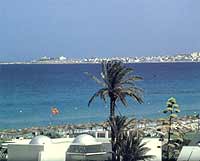
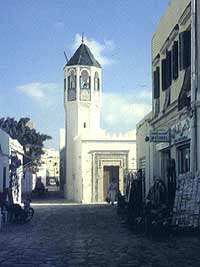
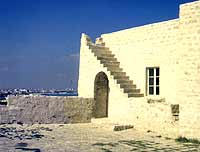
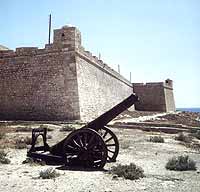
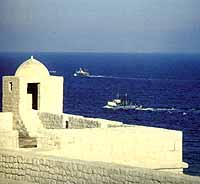
"In 1907, on the high seas of Mahdia, several kilometers from the northeasterly coast of this prestigious town, some sponge divers came across a hoard of ancient objects hidden beneath the water, including architectural columns and capitals. Subsequent excavations revealed that they had come from a boat laden with objects d'art and were intended to be used in the construction of a magnificent building.
What a rich cargo it tourned out to be! As well as the columns and superb marble capitals, they also found bronze masterpieces of Eros with his zither, Hermes of Dionysos and a dancing dwarf as well as marble sculptures like the bust of Aphrodite which has a divine beauty.
Mahdia
and
the
Mediterranean
Part
of
Mahdia's
charm
lies
with
its
maritime
heritage.
Its
fishing
port
is
one
of
the
most
important
in
Tunisia
and
the
local
specialty
is
sardines,
caught
by
lamplight.
The
flicker
of
a
thousand
candles
illuminating
the
sea
when
the
trawlers
set
off
is
a
fascinating
sight
on
summer
evenings.
"It
is
at
the
first
light
of
summer
that
the
port
is
at
its
most
animated,
when
the
fishermen
announce
their
return
bringing
with
them
hundreds
and
thousands
of
crates
packed
with
sardines,
anchovies
and
herrings,
all
caught
on
the
high
seas."
The
Marine
Cemetery
"The
magical
cemetery
of
Mahdia,
immaculately
white,
stretches
from
one
shore
of
the
promontory
to
the
other.
With
fields
of
bright
yellow
daisies
in
spring
and
the
shadows
cast
by
the
surrounding
ramparts,
or
the
remains
of
fishing
boat
against
a
rock
in
the
nearby
inlet,
this
marine
cemetery
evokes
a
unique
sense
of
peace
and
spiritual
calm."
Holidaying
in
Mahdia
Tunisia's
most
beautiful
beaches,
with
fine
pearly
sand,
stretch
from
Ksour
Essaf
to
Chebba.
Mahdia
is
right
at
the
heart
of
them
and
boasts
a
multitude
of
star-rated
hotels
that
have
won
international
awards
for
their
architectural
charm
and
distinctive
emphasis
on
light
and
shade.
Added
to
this
are
the
wonderful
leisure
and
relaxation
facilities,
making
Mahdia
an
unbeatable
holiday
destination.
EGYPT - SYRIA - JORDAN